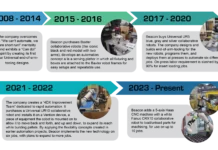by Ashley Burleson, membership and analytics manager
MAPP
Ninety-nine percent of plastics companies have a tracking system in place for machine maintenance, according to a recent study conducted by the Manufacturers Association for Plastics Processors (MAPP). Additionally, 90 percent of companies have a system to track mold maintenance in their facilities.
The Mold and Machine Maintenance Report, published in late spring 2018 by MAPP, was generated by a survey of US plastics companies. The report, which includes 32 pages of aggregated data and results from 131 companies located across 28 states, includes inputs from molders of all sizes, processes and capabilities. The data within this report often are presented by company annual sales, number of active tools or number of active machines to allow users to benchmark their organizations against those of similar size and capabilities.
While the vast majority of plastics companies have systems in place for tracking mold and machine maintenance, only 66 percent report use of the same system or software for tracking both mold and machine maintenance – meaning many companies are using two separate systems or processes for maintenance activities. The tracking systems, in general, vary across all organizations.
For instance, 58 percent of companies use a purchased software, such as IQMS, for the mold maintenance tracking, while approximately 25 percent use a home-grown system, and six percent are relying on manual tracking of maintenance activities. Not surprisingly, mid- to large-sized plastics processors are more likely to utilize a purchased software than their smaller counterparts.
Nearly identical trends are seen when examining machine maintenance tracking systems, with 60 percent of organizations using a purchased software and 15 percent manually tracking machine maintenance activities. Smaller organizations are the most likely to manually track both mold and machine maintenance – and are the most likely to report not tracking machine maintenance.
Machine maintenance activities had additional metrics that companies tracked, such as meantime between failures, proactive vs. reactive time spent by maintenance technicians, technician response time and machine downtime. Only slightly more than 25 percent of processors track meantime between failures, while less than 10 percent track technician response time. Ninety percent of companies track machine downtime, with the practice becoming more common the larger an organization becomes and the more machines a company operates. All companies with more than 50 machines report having a system in place to track downtime. Most commonly, processors rely on the maintenance system to track the machine downtime (32 percent).
However, many companies utilize personnel to track downtime. Outside of operators logging downtime, participants report that foremen, supervisors, process engineers and set-up techs at various organizations are responsible for tracking downtime, either manually or in their maintenance/ERP software. Having personnel track downtime may be leading to challenges for organizations, however, as enforcing standardized and accurate tracking becomes a barrier.
Having strong maintenance tracking in place is necessary as companies are feeling the pressure to maximize machine utilization and avoid unplanned downtime to keep costs low and remain competitive. This is why some companies are leaning away from strictly productive maintenance (PM) to predictive maintenance (PdM). Predictive maintenance allows companies to maximize the useful life of parts and minimize both planned and unplanned downtime. Currently, only slightly more than 25 percent of plastics companies have instituted PdM plans at their facilities, while 65 percent continue to rely solely on the PM plans for their molds and machines. In the future, it is likely these numbers will shift as processors look to become as efficient as possible in an industry that continues to become more competitive.
More information or to purchase the full 32-page report: www.mappinc.com







